
- •Radio Engineering for Wireless Communication and Sensor Applications
- •Contents
- •Preface
- •Acknowledgments
- •1 Introduction to Radio Waves and Radio Engineering
- •1.1 Radio Waves as a Part of the Electromagnetic Spectrum
- •1.2 What Is Radio Engineering?
- •1.3 Allocation of Radio Frequencies
- •1.4 History of Radio Engineering from Maxwell to the Present
- •2.2 Fields in Media
- •2.3 Boundary Conditions
- •2.4 Helmholtz Equation and Its Plane Wave Solution
- •2.5 Polarization of a Plane Wave
- •2.6 Reflection and Transmission at a Dielectric Interface
- •2.7 Energy and Power
- •3 Transmission Lines and Waveguides
- •3.1 Basic Equations for Transmission Lines and Waveguides
- •3.2 Transverse Electromagnetic Wave Modes
- •3.3 Transverse Electric and Transverse Magnetic Wave Modes
- •3.4 Rectangular Waveguide
- •3.4.1 TE Wave Modes in Rectangular Waveguide
- •3.4.2 TM Wave Modes in Rectangular Waveguide
- •3.5 Circular Waveguide
- •3.6 Optical Fiber
- •3.7 Coaxial Line
- •3.8 Microstrip Line
- •3.9 Wave and Signal Velocities
- •3.10 Transmission Line Model
- •4 Impedance Matching
- •4.1 Reflection from a Mismatched Load
- •4.2 Smith Chart
- •4.3 Matching Methods
- •4.3.1 Matching with Lumped Reactive Elements
- •4.3.4 Resistive Matching
- •5 Microwave Circuit Theory
- •5.1 Impedance and Admittance Matrices
- •5.2 Scattering Matrices
- •5.3 Signal Flow Graph, Transfer Function, and Gain
- •6.1 Power Dividers and Directional Couplers
- •6.1.1 Power Dividers
- •6.1.2 Coupling and Directivity of a Directional Coupler
- •6.1.3 Scattering Matrix of a Directional Coupler
- •6.1.4 Waveguide Directional Couplers
- •6.1.5 Microstrip Directional Couplers
- •6.2 Ferrite Devices
- •6.2.1 Properties of Ferrite Materials
- •6.2.2 Faraday Rotation
- •6.2.3 Isolators
- •6.2.4 Circulators
- •6.3 Other Passive Components and Devices
- •6.3.1 Terminations
- •6.3.2 Attenuators
- •6.3.3 Phase Shifters
- •6.3.4 Connectors and Adapters
- •7 Resonators and Filters
- •7.1 Resonators
- •7.1.1 Resonance Phenomenon
- •7.1.2 Quality Factor
- •7.1.3 Coupled Resonator
- •7.1.4 Transmission Line Section as a Resonator
- •7.1.5 Cavity Resonators
- •7.1.6 Dielectric Resonators
- •7.2 Filters
- •7.2.1 Insertion Loss Method
- •7.2.2 Design of Microwave Filters
- •7.2.3 Practical Microwave Filters
- •8 Circuits Based on Semiconductor Devices
- •8.1 From Electron Tubes to Semiconductor Devices
- •8.2 Important Semiconductor Devices
- •8.2.1 Diodes
- •8.2.2 Transistors
- •8.3 Oscillators
- •8.4 Amplifiers
- •8.4.2 Effect of Nonlinearities and Design of Power Amplifiers
- •8.4.3 Reflection Amplifiers
- •8.5.1 Mixers
- •8.5.2 Frequency Multipliers
- •8.6 Detectors
- •8.7 Monolithic Microwave Circuits
- •9 Antennas
- •9.1 Fundamental Concepts of Antennas
- •9.2 Calculation of Radiation from Antennas
- •9.3 Radiating Current Element
- •9.4 Dipole and Monopole Antennas
- •9.5 Other Wire Antennas
- •9.6 Radiation from Apertures
- •9.7 Horn Antennas
- •9.8 Reflector Antennas
- •9.9 Other Antennas
- •9.10 Antenna Arrays
- •9.11 Matching of Antennas
- •9.12 Link Between Two Antennas
- •10 Propagation of Radio Waves
- •10.1 Environment and Propagation Mechanisms
- •10.2 Tropospheric Attenuation
- •10.4 LOS Path
- •10.5 Reflection from Ground
- •10.6 Multipath Propagation in Cellular Mobile Radio Systems
- •10.7 Propagation Aided by Scattering: Scatter Link
- •10.8 Propagation via Ionosphere
- •11 Radio System
- •11.1 Transmitters and Receivers
- •11.2 Noise
- •11.2.1 Receiver Noise
- •11.2.2 Antenna Noise Temperature
- •11.3 Modulation and Demodulation of Signals
- •11.3.1 Analog Modulation
- •11.3.2 Digital Modulation
- •11.4 Radio Link Budget
- •12 Applications
- •12.1 Broadcasting
- •12.1.1 Broadcasting in Finland
- •12.1.2 Broadcasting Satellites
- •12.2 Radio Link Systems
- •12.2.1 Terrestrial Radio Links
- •12.2.2 Satellite Radio Links
- •12.3 Wireless Local Area Networks
- •12.4 Mobile Communication
- •12.5 Radionavigation
- •12.5.1 Hyperbolic Radionavigation Systems
- •12.5.2 Satellite Navigation Systems
- •12.5.3 Navigation Systems in Aviation
- •12.6 Radar
- •12.6.1 Pulse Radar
- •12.6.2 Doppler Radar
- •12.6.4 Surveillance and Tracking Radars
- •12.7 Remote Sensing
- •12.7.1 Radiometry
- •12.7.2 Total Power Radiometer and Dicke Radiometer
- •12.8 Radio Astronomy
- •12.8.1 Radio Telescopes and Receivers
- •12.8.2 Antenna Temperature of Radio Sources
- •12.8.3 Radio Sources in the Sky
- •12.9 Sensors for Industrial Applications
- •12.9.1 Transmission Sensors
- •12.9.2 Resonators
- •12.9.3 Reflection Sensors
- •12.9.4 Radar Sensors
- •12.9.5 Radiometer Sensors
- •12.9.6 Imaging Sensors
- •12.10 Power Applications
- •12.11 Medical Applications
- •12.11.1 Thermography
- •12.11.2 Diathermy
- •12.11.3 Hyperthermia
- •12.12 Electronic Warfare
- •List of Acronyms
- •About the Authors
- •Index
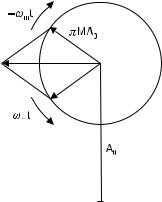
|
Radio System |
297 |
A PM signal can be presented as |
|
|
A (t ) = A 0 |
cos [2pf 0 t + c(t )] |
(11.38) |
= A 0 |
[cos (2pf 0 t ) cos c (t ) − sin (2p f 0 t ) sin c(t )] |
|
If c(t ) is small, cos c(t ) ≈ 1 and sin c (t ) ≈ c (t ), and (11.38) is simplified into form
A (t ) ≈ A 0 [cos (2pf 0 t ) − sin (2pf 0 t ) c(t )] |
(11.39) |
When the modulating signal is sinusoidal c(t ) = 2p M cos (2p f m t ), we obtain
A (t ) ≈ A 0 {cos (2p f 0 t ) − p M sin [2p ( f 0 + f m ) t ] − pM sin [2p( f 0 − f m ) t ]} (11.40)
Equation (11.40) shows that the spectrum of a PM signal contains frequencies f 0 , f 0 + f m , and f 0 − f m , as an AM signal does, but now the phases of these components are different. Figure 11.22 represents a phasor diagram of the PM signal.
11.3.2 Digital Modulation
An analog signal, such as a voice signal in the form of an audio-frequency electric signal, can be transformed into a digital form by sampling it frequently
Figure 11.22 Phasor presentation of a PM signal.
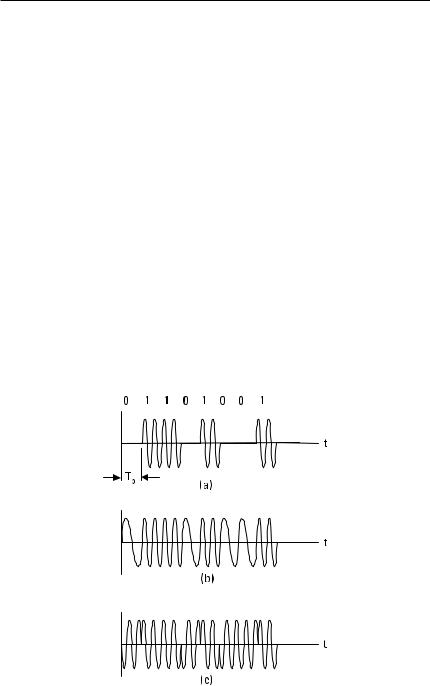
298 Radio Engineering for Wireless Communication and Sensor Applications
enough. A digital signal may be binary, that is, containing only symbols 0 and 1, or m -ary, containing m different levels or states. The digital modulation has many advantages over the analog modulation; the total use of spectrum is effective, immunity to interference is good, frequency reuse is effective, TDM is easily realized, and it allows the use of encryption for privacy.
The basic digital modulation methods are amplitude-shift keying (ASK), frequency-shift keying (FSK), and phase-shift keying (PSK). Figure 11.23 shows the waveforms of binary ASK, FSK, and PSK signals when a symbol chain 01101001 is transmitted. In ASK, the maximum amplitude corresponds to symbol 1 and a zero amplitude corresponds to symbol 0. In FSK, the symbols are presented by signals with frequencies f 1 and f 2 . In PSK, signals corresponding to symbols 1 and 0 have a phase difference of 180°. While analog FM and PM signals closely resemble each other, FSK and PSK signals are easily distinguishable.
In digital modulation, rapid waveform changes occur and thus the power spectrum of a digitally modulated signal is broad. Figure 11.24 shows the spectra of a binary baseband signal consisting of rectangular pulses and a PSK signal modulated with it. The envelopes of the spectra have the shape of a sinc function. The width between the first nulls of the PSK spectrum is twice the bit rate 1/Tb , where Tb is the symbol period. In practice, the signal is filtered and the spectrum is narrower.
Figure 11.23 Waveforms of digitally modulated signals: (a) ASK, (b) FSK, and (c) PSK.
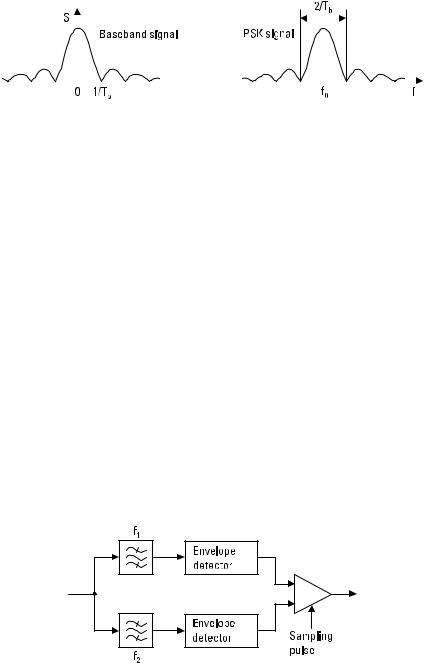
|
|
Radio System |
299 |
|||
|
|
|
|
|
|
|
|
|
|
|
|
|
|
|
|
|
|
|
|
|
Figure 11.24 Spectra of a digital baseband signal and a PSK signal modulated with it.
In a binary modulation each symbol contains one bit of information. In a modulation scheme having 2m different states each symbol contains m bits. Then it is possible to transmit more information in a given bandwidth or to use a narrower band to transmit a given signal having a given bit rate. A four-state FSK (4FSK), four-state PSK (4PSK or QPSK), and eight-state PSK
(8PSK) are examples of modulation methods that save spectrum compared to the binary methods. In a digital QAM, both the amplitude and phase get several discrete values and the number of states may be 16, 64, or even higher. Therefore QAM is used in high-capacity links requiring effective use of the spectrum.
11.3.2.1 FSK
FSK can be realized by frequency modulating an oscillator or by switching between two oscillators operating at two different frequencies. The receiver may consist of two bandpass filters tuned for the frequencies f 1 and f 2 , and followed by envelope detectors. Decision between symbols 1 and 0 is made based on the output voltage of each detector. Such an FSK demodulator, presented in Figure 11.25, is said to be noncoherent.
A coherent demodulator, shown in Figure 11.26, provides a smaller bit error rate (BER). In the receiver, the frequencies f 1 and f 2 are regenerated, and their phases are synchronized with the incoming signal. The output
Figure 11.25 A noncoherent FSK demodulator.
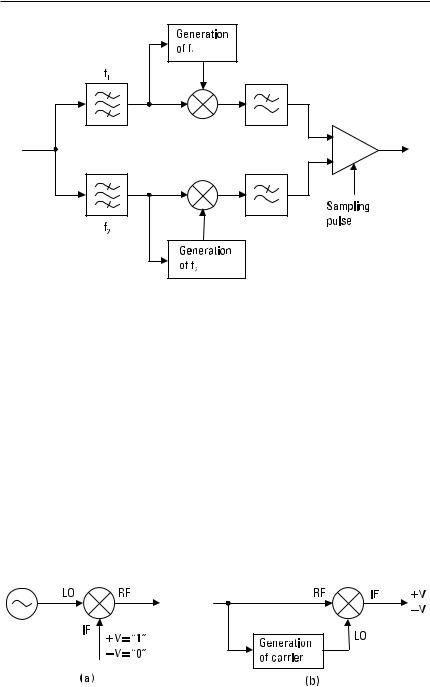
300 Radio Engineering for Wireless Communication and Sensor Applications
Figure 11.26 A coherent FSK demodulator.
voltage of a phase detector (a double-balanced mixer) is proportional to the phase difference of these two signals. After filtering, the amplitudes are compared at the sampling time, and a decision is made between 1 and 0.
Minimum-shift keying (MSK) is a special case of FSK having the smallest separation of frequencies f 1 and f 2 so that the correlation between the symbols corresponding to 1 and 0 is zero. For MSK, the difference between f 1 and f 2 is half of the bit rate.
11.3.2.2 PSK
PSK can be realized by switching between two oscillators that have the same frequency but opposite phase, or with a double-balanced mixer, as shown in Figure 11.27(a). The double-balanced mixer acts as a polarity-reversing switch: When the sign of the voltage fed into the IF port changes, the phase of the carrier output from the RF port changes 180°. Demodulation takes
Figure 11.27 PSK: (a) modulation and (b) demodulation with a double-balanced mixer.
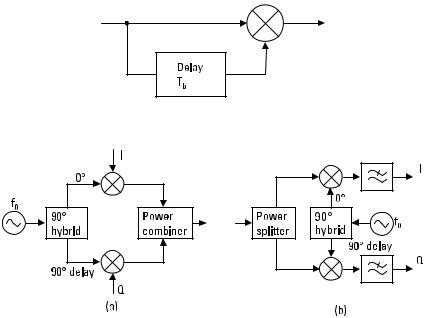
Radio System |
301 |
place in a reversed order, as in Figure 11.27(b). The carrier is regenerated in the receiver and fed into the LO port. The double-balanced mixer acts as a phase detector, and therefore the voltage from the IF port is either positive (+V = ‘‘1’’) or negative (−V = ‘‘0’’).
It may be difficult to get a phase synchronism between the carrier and the local oscillator during a period of only a few symbols. This difficulty can be avoided, and it is not necessary to generate the carrier in the receiver, if the phase of successive symbols is compared. Figure 11.28 shows such a differential PSK (DPSK) demodulator, where the signal is compared in a phase detector with the signal delayed by one symbol period Tb .
In quadriphase-shift keying (QPSK), the phase has four possible values, and each symbol corresponds to two bits: phase p/4 corresponds to 10, 3p /4 corresponds to 00, 5p/4 corresponds to 01, and 7p/4 corresponds to 11. A QPSK signal can be generated using the circuitry shown in Figure 11.29(a). The first bit of the pair is fed to the mixer of the upper branch (I = in-phase), and the second bit of the pair to the mixer of the lower branch (Q = quadrature phase). In the demodulator, shown in Figure 11.29(b), the carrier is regenerated and the phase detectors provide output voltages proportional to the bits.
Figure 11.28 A DPSK demodulator.
Figure 11.29 QPSK: (a) modulation and (b) demodulation.
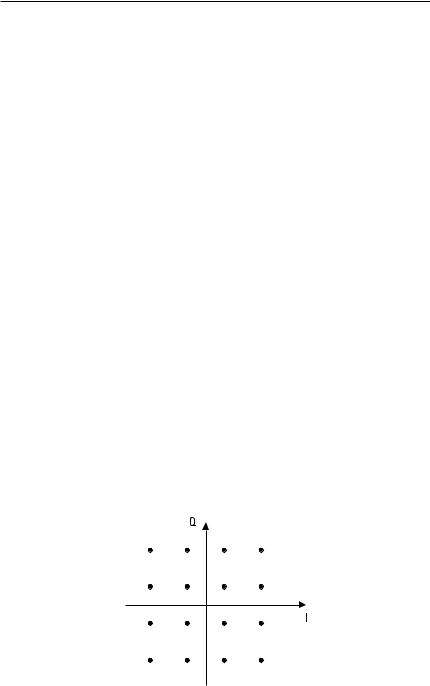
302 Radio Engineering for Wireless Communication and Sensor Applications
11.3.2.3 QAM
The circuits in Figure 11.29 are also called an IQ-modulator and an IQdemodulator. They may be used to generate and detect digital QAM signals. For example, a 16QAM signal may be produced as a sum of a four-level I-signal and a four-level Q-signal. Figure 11.30 shows the constellation of the 16QAM signal on the IQ-diagram. Each point of the constellation presents one symbol now containing 4 bits. The distance of a point from the origin is proportional to the amplitude of the modulated carrier, and the angle between the positive I-axis and the direction of the point from the origin is analogous to the phase of the signal.
11.3.2.4 Comparison of Digital Modulation Methods
An ideal modulation method uses the radio spectrum efficiently, is robust against noise, interference, and fading, and can be realized with low-cost and power-efficient circuitry. However, these requirements are partly contradictory, and some tradeoffs have to be made to optimize the overall system performance.
Binary ASK, FSK, and PSK signals can be generated with simple circuits. Because ASK and FSK signals can be demodulated incoherently with an envelope detector, these receivers can also be made simple and inexpensive. Coherent detection of ASK and FSK requires more complex circuits but provides a lower BER. PSK has the lowest BER but requires generation of a synchronized carrier in the receiver.
Figure 11.31 shows how the bit error rate of a PSK system depends on the S /N in an ideal AWGN channel and in a Rayleigh channel. In the AWGN channel, white noise is the only nonideality. An S /N of only about 7 dB is needed to achieve a BER of 10−3. Coherent FSK needs 3 dB higher
Figure 11.30 Constellation of 16QAM.
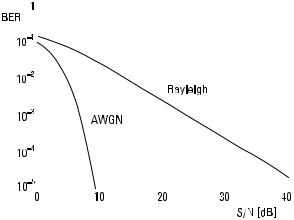
|
|
|
|
Radio System |
303 |
||||||
|
|
|
|
|
|
|
|
|
|
|
|
|
|
|
|
|
|
|
|
|
|
|
|
|
|
|
|
|
|
|
|
|
|
|
|
|
|
|
|
|
|
|
|
|
|
|
|
|
|
|
|
|
|
|
|
|
|
|
|
|
|
|
|
|
|
|
|
|
|
|
|
|
|
|
|
|
|
|
|
|
|
|
|
|
|
|
|
|
|
|
|
|
|
|
|
Figure 11.31 The BER of PSK systems in AWGN and Rayleigh channels.
S /N than PSK for a similar performance. In the AWGN channel BER decreases exponentially as S /N increases. In the Rayleigh fading channel a much higher average S /N is required for a given BER, because during deep fades the error rate is large. ASK has a very poor performance in the Rayleigh channel, because the threshold level between 0 and 1 depends on the signal level; FSK and PSK have no such problem.
The bandwidth efficiency describes how well a modulation method uses a limited bandwidth. The bandwidth efficiency of binary modulation methods is slightly less than 1 bit in 1 second per 1 hertz bandwidth. As noted before, increasing the number of modulation states lowers the symbol rate, making the spectrum narrower. Thus multistate methods have better bandwidth efficiencies than binary methods. However, for a given signal power the states become closer to each other, making the system more susceptible to noise and interference. Also, the equipment requirements of a multistate method are demanding. For example, an imbalance of the branches of an IQ-modulator and IQ-demodulator, and the phase noise of an oscillator may easily increase the BER.
In case of multistate QAM, the amplitude variations are large. Therefore transmitters and receivers have to operate linearly; otherwise, the signal will distort and the occupied bandwidth will grow. Modulation methods such as MSK, producing a constant-envelope waveform, allow the use of nonlinear power amplifiers in transmitters. As discussed in Section 8.4, nonlinear amplifiers are more efficient than linear amplifiers. Power efficiency is an important factor in battery-powered transmitters.
